
Euphorbia is a very large and diverse genus of flowering plants, commonly called spurge, in the family Euphorbiaceae.

Euphorbia esula, commonly known as green spurge or leafy spurge, is a species of spurge native to central and southern Europe, and eastward through most of Asia north of the Himalaya to Korea and eastern Siberia. It can also be found in some parts of Alaska.

Euphorbia heterophylla, also known under the common names of Mexican fireplant, painted euphorbia, Japanese poinsettia, paintedleaf, painted spurge and milkweed, is a plant belonging to the Euphorbiaceae or spurge family.

Euphorbia myrsinites, the myrtle spurge, blue spurge, or broad-leaved glaucous-spurge, is a succulent species of flowering plant in the spurge family Euphorbiaceae.
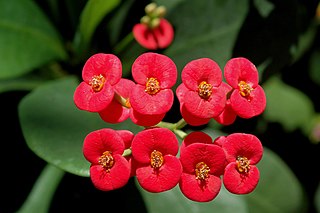
Euphorbia milii, the crown of thorns, Christ plant, or Christ's thorn, is a species of flowering plant in the spurge family Euphorbiaceae, native to Madagascar. The species name commemorates Baron Milius, once Governor of Réunion, who introduced the species to France in 1821.

Euphorbia resinifera, the resin spurge, is a species of spurge native to Morocco, where it occurs on the slopes of the Atlas Mountains. The dried latex of the plant was used in ancient medicine. It contains resiniferatoxin, an extremely potent capsaicin analog tested as an analgesic since 1997.

Euphorbia lathyris, the caper spurge or paper spurge, is a species of spurge native to southern Europe, northwest Africa, and eastward through southwest Asia to western China.
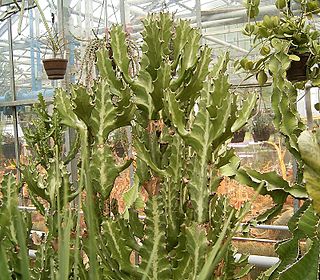
Euphorbia lactea is a species of spurge native to arid and subtropical regions of South Asia, mainly the Indian Subcontinent.
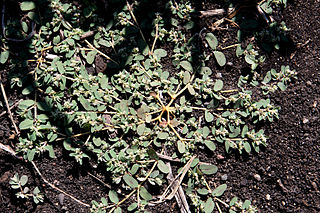
Euphorbia maculata, known as spotted spurge, prostrate spurge, milk purslane, or spotted sandmat, is a fast-growing annual plant in the family Euphorbiaceae. While it is native to North America, where it is a common garden and lawn weed in the United States, it has become a common introduced species throughout the world, including Europe, Japan, Korea, Australia, and New Zealand.

Euphorbia canariensis, commonly known as the Canary Island spurge, Hercules club or in Spanish cardón, is a succulent member of the genus Euphorbia and family Euphorbiaceae endemic to the Canary Islands. It is the plant symbol of the island of Gran Canaria.
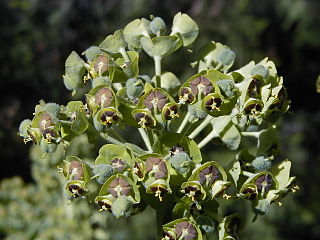
Euphorbia characias, the Mediterranean spurge or Albanian spurge, is a species of flowering plant in the family Euphorbiaceae typical of the Mediterranean vegetation. It is an upright, compact evergreen shrub growing to 1.2 m tall and wide.
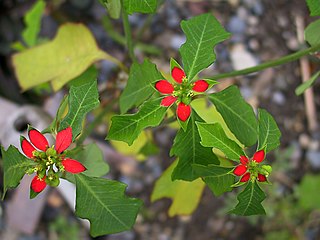
Euphorbia cyathophora, known by various names including painted spurge, dwarf poinsettia, fire-on-the-mountain, paintedleaf, and wild poinsettia. Native to subtropical and tropical North and South America, it is widely naturalized elsewhere. They belong to the Cyathium type of inflorescence. Here, the inflorescence axis is convex in shape. Dwarf poinsettia is an annual herb growing up to 3 feet tall. It has green stems with leaves that are oblanceolate with lobed margins. It grows near disturbed sites.

Euphorbia aeruginosa is a succulent member of the spurge family native to South Africa. It grows as a small shrub, in sandy soils and in the fractures of rocks sending up multiple spiny blue-green photosynthetic stems. The plant produces yellow cyathia or flowering heads.

Euphorbia missurica, commonly called prairie sandmat, or Missouri spurge, is a species of flowering plant in the spurge family (Euphorbiaceae). It is native to North America, where it is found primarily in area of the Great Plains. Its natural habitat is in dry, often calcareous areas, including glades, bluffs, and open woodlands.

Euphorbia davidii, known as David's spurge or toothed spurge, is a species of flowering plant in the spurge family Euphorbiaceae. It is an annual herb growing up to 2 feet tall. Leaves are opposite in arrangement with narrow to broadly elliptic blades.

The Crete Mediterranean forests is a terrestrial ecoregion that encompasses the Greek island of Crete.
Euphorbia alsiniflora, is a species of flowering plant, belonging to the family Euphorbiaceae. It is native to Australia in the Northern Territory and Queensland.
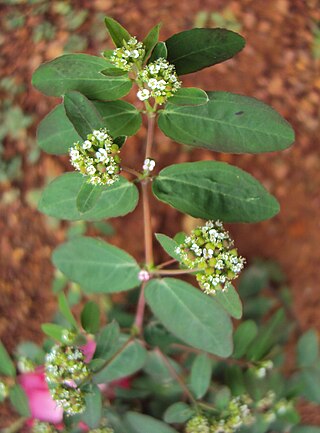
Euphorbia hypericifolia is a species of perennial herb in the genus Euphorbia native to tropical Americas. It normally grows up to 2 feet (0.6 m) in height, and contains milky sap which can cause skin and eye irritation.
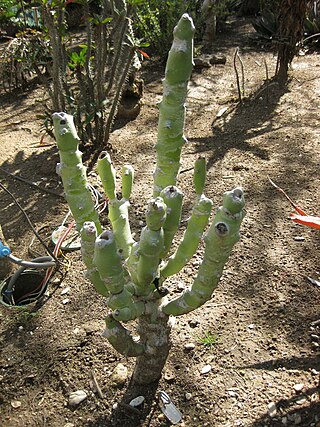
Euphorbia caducifolia is a subtropical succulent species of flowering plant in the spurge family Euphorbiaceae. It is found in the arid regions of northwestern Indian subcontinent. In India it is known as the leafless milk hedge.

Euphorbia segetalis, the grainfield spurge, is a species of annual herb in the family Euphorbiaceae. They have a self-supporting growth form and simple, broad leaves. Flowers are visited by Plagiolepis pygmaea, Polistes, and nomad bees. Individuals can grow to 16 cm tall.



















